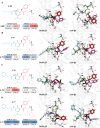Carmaphycin B-Based Proteasome Inhibitors to Treat Human African Trypanosomiasis: Structure-Activity Relationship and In Vivo Efficacy
- PMID: 39589805
- PMCID: PMC11650654
- DOI: 10.1021/acsinfecdis.4c00441
Carmaphycin B-Based Proteasome Inhibitors to Treat Human African Trypanosomiasis: Structure-Activity Relationship and In Vivo Efficacy
Abstract
The proteasome is essential for eukaryotic cell proteostasis, and inhibitors of the 20S proteasome are progressing preclinically and clinically as antiparasitics. We screenedTrypanosoma brucei, the causative agent of human and animal African trypanosomiasis, in vitro with a set of 27 carmaphycin B analogs, irreversible epoxyketone inhibitors that were originally developed to inhibit thePlasmodium falciparum20S (Pf20S). The structure-activity relationship was distinct from that of the human c20S antitarget by the acceptance of d-amino acids at the P3 position of the peptidyl backbone to yield compounds with greatly decreased toxicity to human cells. For the three most selective compounds, binding to the Tb20S β5 catalytic subunit was confirmed by competition with a fluorescent activity-based probe. For one compound, J-80, with its P3 d-configuration, the differential binding to the parasite's β5 subunit was supported by both covalent and noncovalent docking analysis. Further, J-80 was equipotent against both Trypanosoma brucei gambiense and Trypanosoma brucei rhodesiense in vitro. In a mouse model of Stage 1 T. brucei infection, a single intraperitoneal (i.p.) dose of 40 mg/kg J-80 halted the growth of the parasite, and when given at 50 mg/kg i.p. twice daily for 5 days, parasitemia was decreased to below the detectable limit, with parasite recrudescence 48 h after the last dose. The in vivo proof of principle demonstrated by a potent, selective, and irreversible inhibitor of Tb20S reveals an alternative path to the development of kinetoplastid proteasome inhibitors that differs from the current focus on allosteric reversible inhibitors.
Keywords: African trypanosomiasis; carmaphycin B; marine natural product; neglected tropical disease; proteasome inhibitor.
Conflict of interest statement
The authors declare no competing financial interest.
Figures




References
-
- Venturelli A.; Tagliazucchi L.; Lima C.; Venuti F.; Malpezzi G.; Magoulas G. E.; Santarem N.; Calogeropoulou T.; Cordeiro-da-Silva A.; Costi M. P. Current treatments to control African trypanosomiasis and one health perspective. Microorganisms 2022, 10 (7), 129810.3390/microorganisms10071298. - DOI - PMC - PubMed
-
- Papagni R.; Novara R.; Minardi M. L.; Frallonardo L.; Panico G. G.; Pallara E.; Cotugno S.; Bartoli T. A.; Guido G.; Vita E. D.; Ricciardi A.; Totaro V.; Camporeale M.; Segala F. V.; Bavaro D. F.; Patti G.; Brindicci G.; Pellegrino C.; Mariani M. F.; Putoto G.; Samrati L.; Castellani C.; Saracino A.; Gennaro F. D.; Nicastri E. Human African trypanosomiasis (sleeping sickness): Current knowledge and future challenges. Front. Trop. Dis. 2023, 4, 108700310.3389/fitd.2023.1087003. - DOI
MeSH terms
Substances
Grants and funding
LinkOut - more resources
Full Text Sources

